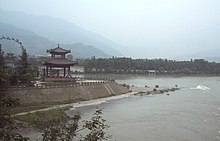Dujiangyan irrigation system
The Dujiangyan irrigation system is located near Dujiangyan City , which is 60 km northwest of Chengdu city center at the point where the Min River (岷江; Pinyin : Mín Jiāng) flows from the hill country into the Chengdu Plain . It is a weir system that has controlled the Min River for 2,300 years and diverts large amounts of water to irrigate the Red Basin . The plants were built from 256 BC. BC to 251 BC Built under the Qin administrator Lǐ Bīng (李冰) and his son. In 2006 they were supplemented by the new Zipingpu dam .
Since 2000, Dujiangyan and Qingcheng Shan have been included on the UNESCO World Heritage List . It has been on the list of monuments of the People's Republic of China since 1982 . Other listed ancient hydraulic engineering projects in China include the Zheng Guo Canal and the Ling Canal .
construction
The system consists of the following areas: the fish mouth (鱼嘴; yŭzŭi), the sand weir (飞沙 堰; fēishāyàn) and the precious bottleneck (宝 瓶口; băopíngkŏu).
The fish's mouth is a shallow dike that divides the Min lengthwise into an inner and outer stream. A higher dike has been built on the fish's mouth - a little set back. The outer, westerly stream continues to flow as Min, while the inner, eastward stream serves as a source for the water to be diverted. The shape of the fish's mouth causes a seasonally different distribution of the water masses. In the arid spring, 40% of the water flows into the outer stream and 60% into the inner one; During the high water season, the water level rises, so that it floods the fish's mouth and the distribution is reversed: now 60% of the water flows into the outer stream. Due to the construction, the deep water with the majority of sand and suspended particles is directed into the outer stream, while the clearer surface water flows into the inner channel.
There is an overflow to control the amount of water in the inner stream. This is the sand weir , a 710 m downhill and 240 m wide opening in the dike. During floods, the excess flows through the weir into the outer stream, and sand and stones are also washed out, which prevents the inner stream from becoming silted up.
The water for the fields in the Chengdu plain is then diverted through the precious bottleneck . The precious bottle neck is an artificial incision in the mountain flank of the Yulei Shan (玉垒山), 120 m away from the outlet of the sand weir . It is up to 28.9 m wide, 18.8 m high and has a length of 36 m. Following the natural gradient, it flows in canals to the southeast and irrigates the Chengdu Plain.
Web links
- Mount Qingcheng and the Dujiangyan Irrigation System. Entry on the UNESCO World Heritage List
Individual evidence
- ↑ UNESCO World Heritage Center: Mount Qingcheng and the Dujiangyan Irrigation System. Accessed August 17, 2017 .
Coordinates: 31 ° 0 ′ 33 ″ N , 103 ° 36 ′ 16 ″ E


